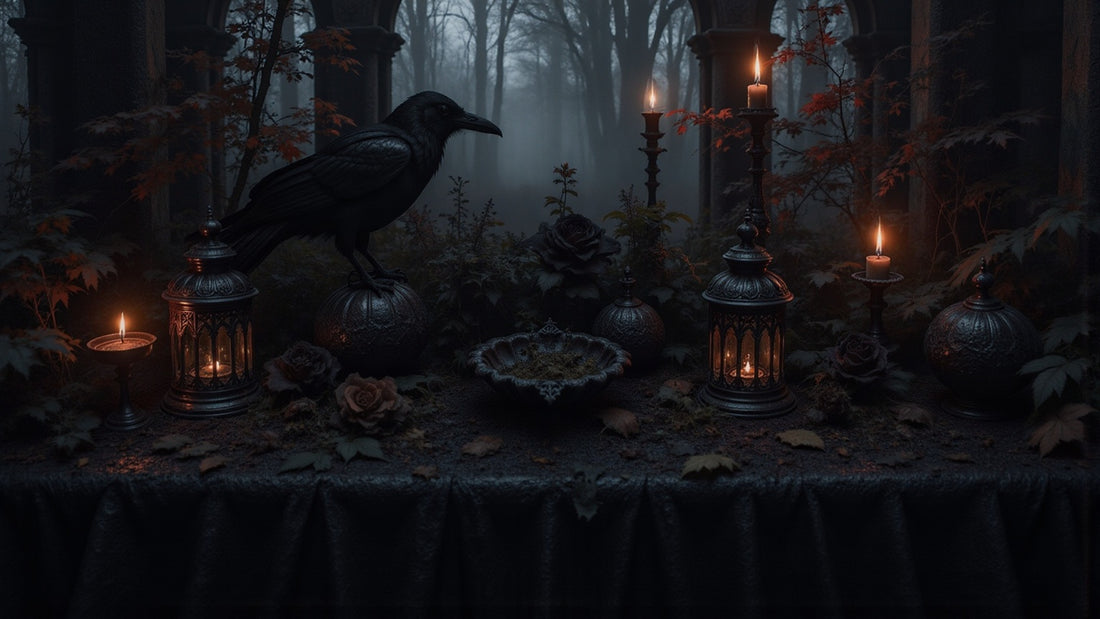
What is Gothabilly? Understanding the Aesthetic and Its Cultural Roots
Share
Overview
Gothabilly—a cultural movement that fuses the dark allure of goth with the infectious beats of rockabilly. It emerged in the late 1970s, with bands like The Cramps leading the charge. But what does this genre really represent? Individuality and rebellion, wrapped in a vibrant community that revels in self-expression through fashion and music. This is not just a scene; it's a lifestyle, a statement.
The resurgence of gothabilly in contemporary culture is more than a trend; it's a powerful reminder of the beauty found in darkness. It beckons you to explore its depths, to understand the seductive pull of its aesthetics. Are you ready to dive into a world where every stitch of clothing and every note played tells a story of defiance?
Join a community that celebrates the unconventional, where the past collides with the present, and self-expression reigns supreme. Gothabilly is calling—will you answer?
Introduction
In a world where music and fashion collide, Gothabilly emerges—a striking fusion of gothic elegance and rockabilly charm. Born from the creative depths of the late 1970s, this genre pulses with a unique aesthetic that resonates with those drawn to the haunting allure of gothic culture and the electrifying rhythms of rockabilly. Dark motifs and retro influences swirl together, inviting enthusiasts to explore their individuality through a rich tapestry of self-expression. This cultural movement captivates new generations, forging connections that celebrate the unconventional and offering a tantalizing glimpse into a realm where darkness dances with nostalgia. Ready to dive deeper?
Defining Gothabilly: An Overview of the Aesthetic
This captivating style and musical category seamlessly intertwines the eerie allure of dark culture with the nostalgic vibe of rockabilly. Born in the late 1970s, the term 'Gothabilly' emerged from the creative sparks of bands like The Cramps, who played a pivotal role in bringing this unique fusion to life. Picture dark, moody visuals colliding with upbeat, danceable rhythms—this genre crafts a sound that resonates with a diverse crowd.
At its core, gothabilly embodies themes of horror, nostalgia, and rebellion, drawing in those who revel in the charm of dark aesthetics fused with the vibrant energy of rockabilly music. It's more than just fashion or musical taste; it’s a lifestyle that celebrates individuality and creativity within a shadowy framework. Enthusiasts often showcase their identity through a blend of vintage rockabilly attire—think high-waisted skirts, leather jackets, and pompadours—infused with gothic elements like dark makeup, lace, and dramatic accessories.
Statistics reveal a thrilling resurgence in the alternative culture scene, especially among younger crowds captivated by its eclectic mix. This revival pulses through cultural events, music festivals, and social media platforms, where fans share their interpretations of the aesthetic. Cultural experts note that the fusion of alternative and rockabilly styles not only enhances the fashion landscape but also nurtures a sense of community among those embracing this lifestyle.
As Dark Arts emerges as a movement that melds gothic elegance, cannabis wellness, and mystery, it perfectly aligns with the spirit of alternative culture. It invites individuals to delve into their darker inclinations through premium THCA offerings that embody quality and legal compliance.
Darc Arts stands firm on quality with the 'Darc Arts Promise,' ensuring our THCA products are crafted from simple ingredients that illuminate the magic of the unknown. Our products comply with the 2018 Farm Bill, containing less than 0.3% Delta-9 THC on a dry-weight basis, making them federally legal under U.S. law, though some states may impose restrictions. For transparency, we provide a Certificate of Analysis for our products, reinforcing our commitment to consumer privacy and legal adherence.
Chet Atkins once quipped, "The music has gotten pretty bad, I think. It's all that damn line dancing," a cultural commentary that resonates with the genre’s rejection of mainstream trends in favor of a more authentic expression of identity.
This cultural movement often finds its way into lifestyle articles that spotlight its vibrant subculture, showcasing how individuals weave these elements into their daily lives. From themed parties to music events, this lifestyle invites a celebration of the unconventional, encouraging participants to express their darker inclinations with flair. This community aspect is further highlighted by brands like Darc Arts, which cultivates a space where dark elegance and cannabis culture intersect, ensuring transparency and consumer privacy in their offerings.
In essence, this style transcends mere genre or aesthetic; it is a cultural movement urging individuals to explore the convergence of dark elegance and rockabilly vibrancy. By embracing this unique blend, enthusiasts not only celebrate their individuality but also contribute to a rich tapestry of artistic expression that continues to evolve.
The Historical Roots of Gothabilly: From Rockabilly to Gothic Fusion
The vibrant rockabilly movement of the 1950s, born from the electrifying fusion of country music and rhythm and blues, serves as the gritty foundation of gothabilly. Elvis Presley's death in 1977? A seismic shift in rockabilly history, propelling the genre into new realms. As rockabilly evolved, it began to intertwine with the raw energy of the punk rock scene and the dark subculture that emerged in the late 1970s.
Enter the goth subculture—where dark visuals and themes of melancholy found a hauntingly beautiful expression in gothabilly.
This genre thrived in the 1980s and 1990s, as bands dared to merge the lively tempos and dynamic rhythms of rockabilly with eerie melodies and reflective lyrics typical of dark rock. Picture Jerry Lee Lewis, his energetic piano style igniting hits like 'Great Balls of Fire' and 'Whole Lotta Shakin' Goin' On.' His influence on the rockabilly sound? Undeniable. The interplay of rockabilly and goth elements crafted a unique aesthetic, resonating with fans of both genres—a celebration of individuality and expression. As Sonny Burgess, a rockabilly singer/songwriter, boldly states, his group continues to perform today, a testament to the enduring legacy of rockabilly artists.
And let’s not forget Johnny Cash's 'boom-chicka-boom' sound—an essential thread in the fabric of this genre.
As this style evolves, it stands as a testament to the lasting impact of its forerunners, binding the vibrant essence of rockabilly with the melancholic charm of dark culture. The case study of Dark Arts exemplifies this fusion—an embodiment of elegant style and wellness, paralleling the cultural dialogue that pulses through the subculture.
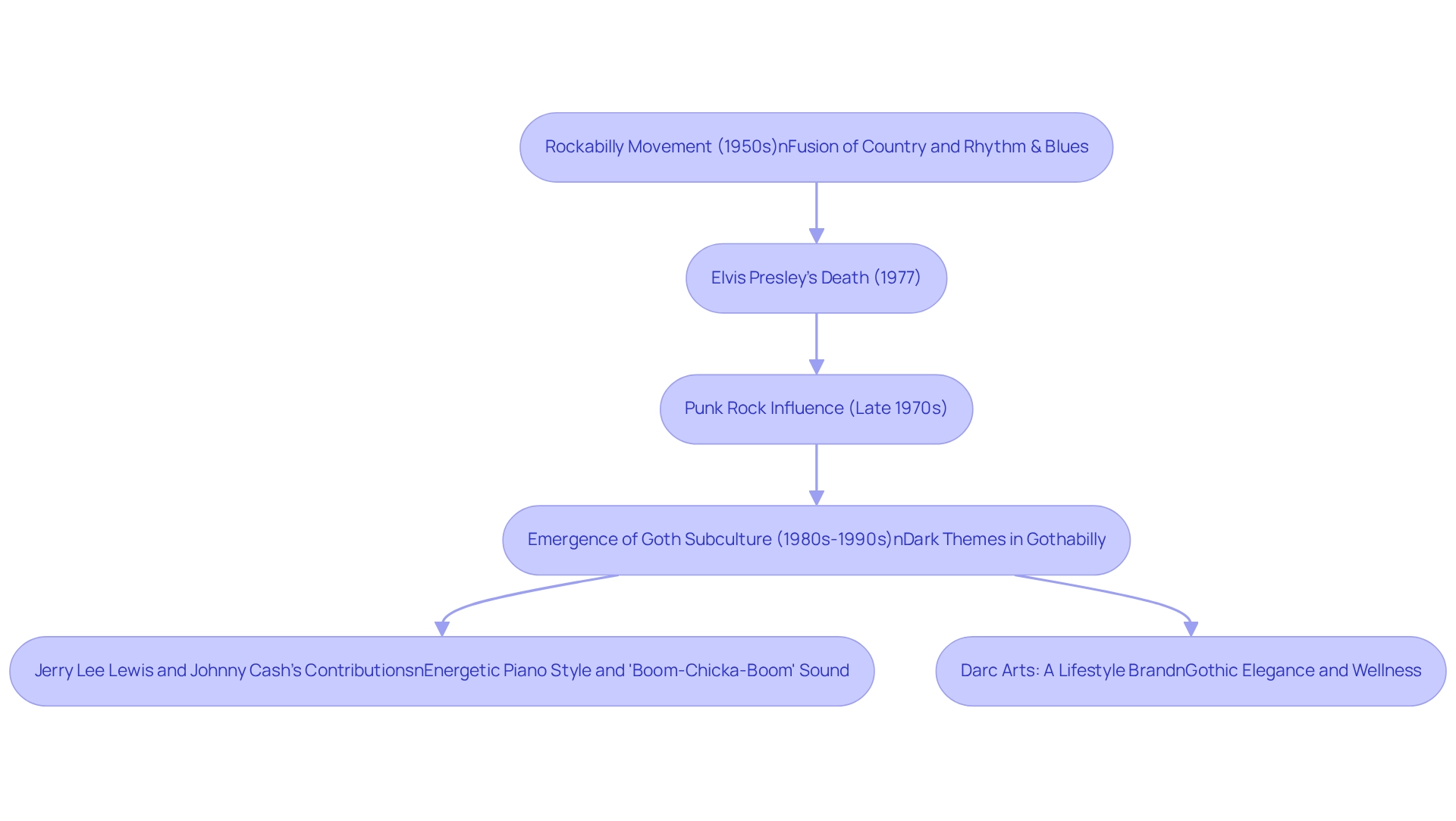
Key Motifs and Visual Elements of Gothabilly
This style is a captivating fusion of vintage rockabilly fashion and gothic aesthetics—gothabilly, as it's often called—crafting a unique visual identity that resonates deeply with its enthusiasts. Central to this aesthetic are motifs like skulls, bats, and horror-themed imagery, often paired with retro patterns such as polka dots and cherries. The color palette? Dark hues—black, red, and purple—complemented by vintage silhouettes that include pencil skirts, fitted jackets, and high-waisted trousers.
Accessories are the lifeblood of alternative rockabilly style. Think fishnet stockings, chokers, and platform shoes, frequently adorning outfits. This visual language not only reflects themes common in alternative rock music but also creates a striking identity for those who embrace this lifestyle.
Recent trends reveal a staggering rise in social media interaction with fashion content—up by 125% since 2024. This surge underscores a growing fascination with various styles, including alternative subcultures. Fashion historians note that the merging of styles within this genre mirrors a broader cultural movement where traditional boundaries blur. As Hannah Rose Owens astutely observes, 'What this truly refers to is an intriguing blend of visual elements that is blurring the boundaries of established style guidelines and expectations, which ought not to be regarded too seriously.'
The gothabilly aesthetic transcends mere style choice; it embodies a lifestyle that celebrates individuality and creativity, much like the ethos of Dark Arts. This brand presents itself as a movement uniting dark elegance, cannabis wellness, and enigma, encouraging enthusiasts to discover their distinctive identities through both style and lifestyle selections. With offerings like the THCA diamond-coated pre-rolls priced at $49.99 USD, Darc Arts enhances the cannabis experience, infusing it with a hauntingly powerful allure that resonates within the dark community.
Common motifs like vintage tattoos, retro hairstyles, and playful horror elements contribute to a vibrant community thriving on self-expression. As this style continues to evolve, it stands as a testament to the enduring allure of gothic culture and its ability to inspire contemporary fashion trends. Don't be scared... it's only THCA.
Core Values and Beliefs of the Gothabilly Community
At its core, gothabilly culture is a wild celebration of individuality, creativity, and the darker sides of life. It’s about nostalgia and rebellion, with members wielding their aesthetic choices like weapons of self-expression. This community thrives on inclusivity, embracing a spectrum of interpretations that invite participants to explore their identities without boundaries.
Blending punk, goth, and gothabilly influences, individuals forge connections through a shared love for the macabre and the unconventional. Music, fashion, and art weave a unifying thread, linking those who dare to embrace the unique and the extraordinary. As Selin Kir puts it, 'The gothabilly subculture’s enduring appeal lies in its ability to evolve and embrace a vast array of influences, resulting in numerous subcategories each with its unique identity.'
And let’s not forget the alternative music scene, which mirrors the values of wellness and safety. Take Darc Arts, for example—crafting premium THCA pre-rolls infused with diamonds, ensuring a hauntingly powerful cannabis experience while keeping THC levels below 0.3%. This means a legal, safe indulgence, allowing consumers to savor the therapeutic benefits of THCA without the psychoactive effects of THC. The roots of this community stretch back to the 59 Club, transforming from a gathering of motorcycle enthusiasts into a global hub for those who live a life of rebellion and creativity.
Through these connections, the subculture continues to honor its rich heritage while crafting a modern narrative that resonates with today’s cannabis culture. Ready to dive deeper into this intoxicating world?
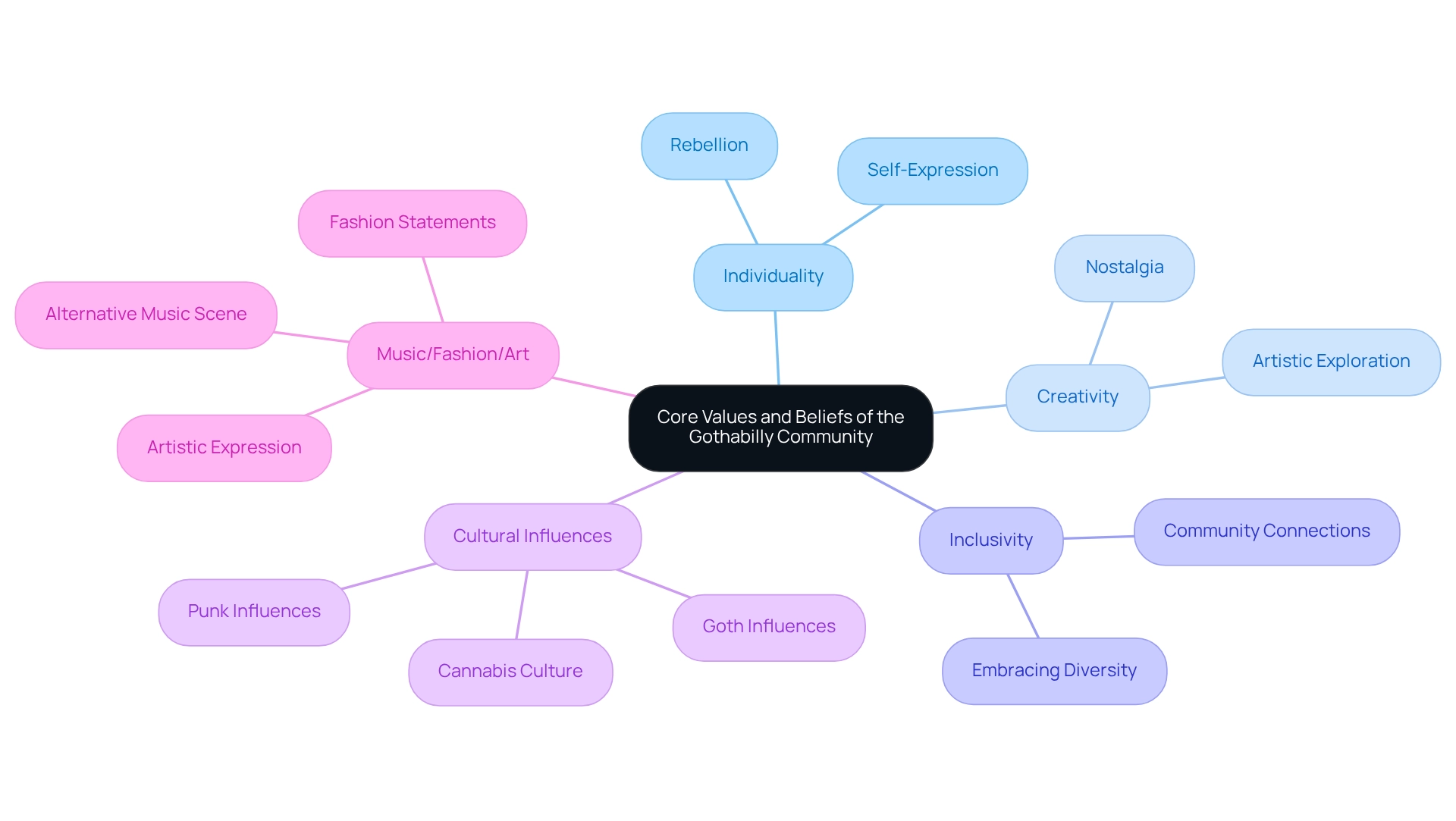
Gothabilly in Context: Related Aesthetics and Cultural Movements
This musical style emerges from the vibrant clash of cultural movements—gothabilly, punk, and rockabilly—each a pulse of rebellion. It not only captures the lively rhythms of rockabilly but also weaves in the dark romanticism and macabre allure of gothabilly, creating a sonic tapestry that is both striking and rich. Picture a world where vintage Americana meets gothic elements, igniting a visually and audibly captivating experience.
Now, psychobilly enters the fray, sharing rockabilly's roots but charging forth with a more aggressive sound, steeped in horror themes and punk influences. Here, the theatricality of gothabilly shines through, revealing an emotional depth that resonates with the soul. This interconnectedness illustrates the fluidity of cultural boundaries; artists and enthusiasts alike blend and borrow elements, forging something uniquely their own.
Witness the ongoing evolution of this genre, a testament to the dynamic nature of subcultures, where influences twist and turn, reshaping identities. Subtypes within the goth community, like 'trad' and 'Victorian', emerge, showcasing a rich diversity that defies simple categorization. As Sabrina Newman pointed out, the debate on the myriad varieties of goth continues, reflecting the ever-changing landscape of cultural movements.
But these cultural currents are not static; they ebb and flow, reacting to societal shifts, mirroring broader trends in music and fashion. Artists in this genre seamlessly weave contemporary themes into their work, all while remaining anchored in historical roots. This genre stands as a vibrant testament to cultural expression, where past and present collide, crafting an evolving aesthetic.
In essence, the bond between this musical style and gothabilly is a dance of shared origins and distinct traits, revealing the intricate web of influences that define these subcultures. A study in the British Medical Journal highlights that identification with the goth subculture can predict self-harm and attempted suicide among young teens, suggesting a need for peer support among those navigating similar experiences. As they evolve, they invite both seasoned enthusiasts and curious newcomers to plunge into the depths of their artistic and cultural narratives—a journey into the unknown where elegance meets wellness.
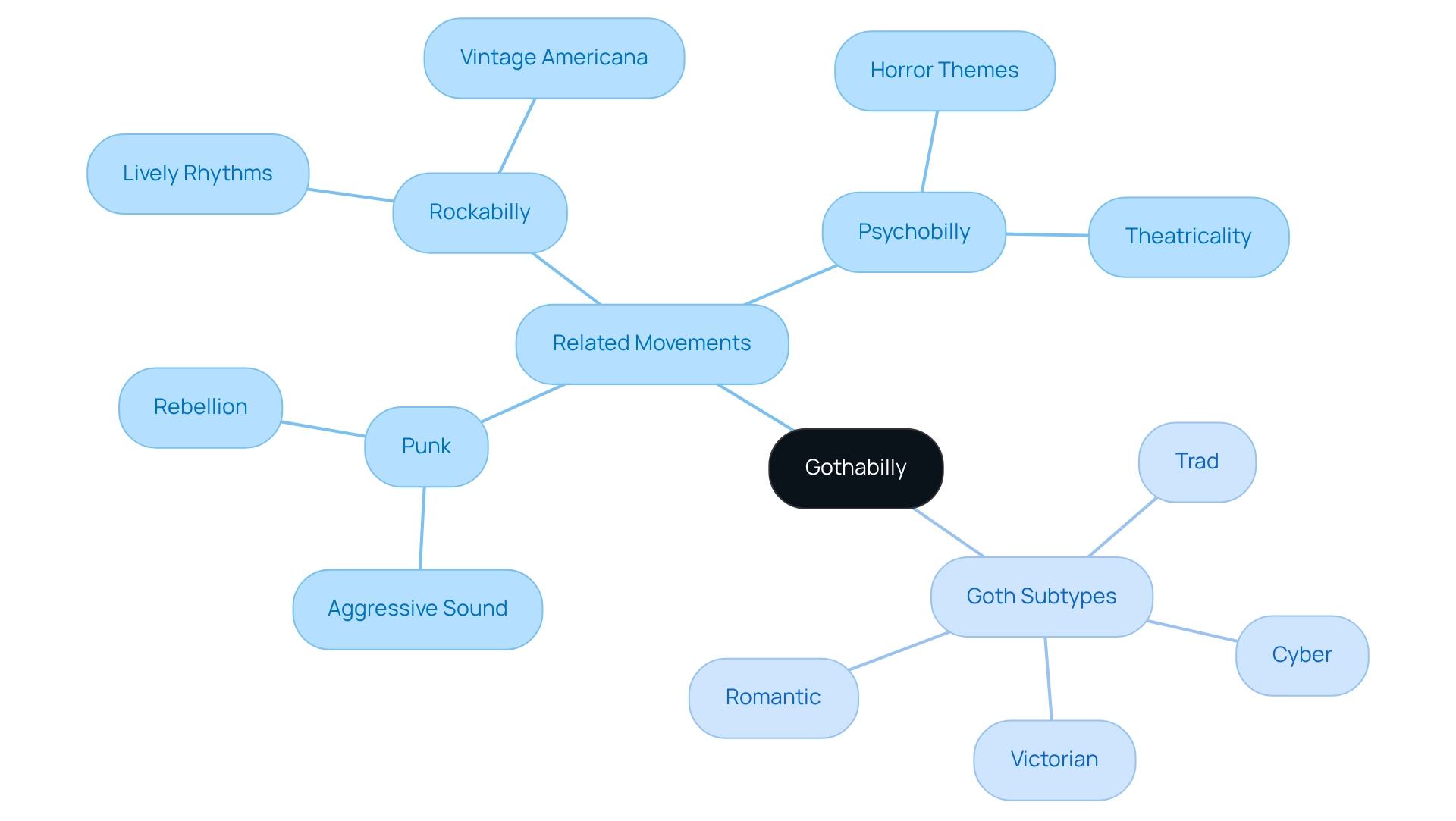
The Sound of Gothabilly: Music and Its Cultural Impact
This genre? A wild collision of rockabilly's electric pulse and gothabilly's shadowy allure. Picture twangy guitars slicing through the air, an upright bass thumping like a heartbeat, and haunting vocals that linger in the night. The lyrics? They plunge into love, loss, and the supernatural, weaving a rich tapestry that ensnares listeners in its grip.
Notable bands like The Cramps and The Phantom Chords have carved their names into the gothabilly landscape, infusing their sound with a dark humor and irony that resonates deeply with devoted fans.
But gothabilly isn't just about sound; it's a cultural force. Its impact ripples through style, art, and film, inspiring a new generation of creators and enthusiasts. Think about it: the themes in its lyrics flirt with the macabre and whimsical, mirroring modern fashion trends that blend dark elements with retro vibes.
Statistics reveal a deeper connection—gothabilly themes resonate on multiple levels, serving as a voice for those entwined in the gothic subculture. Research shows that both male and female Goth fans often grapple with depressive feelings compared to their non-Goth counterparts. This emotional complexity marks the genre as a significant cultural touchstone.
Moreover, case studies on Music Marker Theory unveil how musical preferences shape peer dynamics, especially among the youth. As Tom ter Bogt, a professor of popular music and youth culture, wisely notes, "When working with youth preferring Goth or other types of non-mainstream music, clinicians and other practitioners should be sensitive to the fact that music may mask problem behaviors."
As the genre evolves, its influence on contemporary artists remains undeniable. Many draw inspiration from this distinctive fusion, weaving its elements into their own creations, thus ensuring its legacy lives on. The cultural footprint of gothabilly is evident across artistic realms, showcasing its power to inspire and connect with audiences through the ages.
In 2025, new bands continue to rise, enriching the gothabilly tapestry and solidifying its place in the cultural panorama. This evolution echoes the spirit of brands like Darc Arts, merging gothic elegance, cannabis wellness, and mystery, inviting aficionados to delve into the intricate web of music, culture, and lifestyle.
Notable Gothabilly Bands: Icons of the Genre
The fusion of goth and rockabilly has birthed iconic gothabilly bands, each leaving an unforgettable mark on their distinctive sound and aesthetic. The Cramps, hailed as the innovators of the gothabilly genre, masterfully wove rockabilly with punk influences and horror-themed imagery, crafting a sound that vibrates with life yet haunts the soul. Their legacy? Profound. They didn’t just shape the musical landscape; they ignited a cultural movement that revels in the macabre and the nostalgic, echoing the gothic elegance that Darc Arts embodies through its premium THCA offerings.
Other notable bands? Look no further than The Coffinshakers, known for their chilling lyrics and theatrical performances, captivating audiences with a blend of humor and horror. Ghoultown pushes the boundaries of gothabilly, infusing elements of country and western into their style, creating a unique fusion that resonates with fans from diverse musical backgrounds. Statistics reveal that The Rhythm Coffin has amassed 278 listeners, showcasing the genre's growing popularity and dedicated fanbase.
These bands embody the gothabilly subculture, drawing a devoted following that treasures the blend of nostalgia and darkness. The impact of The Cramps is crystal clear; they’ve inspired countless artists and defined the very essence of the gothabilly genre. As this genre continues to evolve, the contributions of these iconic bands remain essential, ensuring that this style holds its place in the cultural landscape, celebrated for its unique blend of styles and its ability to evoke both nostalgia and intrigue.
In this realm, Darc Arts emerges as a movement, inviting consumers to immerse themselves in the blend of elegant style and cannabis wellness through its premium THCA products. By nurturing a community around its distinctive aesthetic, Dark Arts intertwines itself with the cultural significance of the subculture, creating a space where the dark and the magical converge. The brand weaves a dark allure into its offerings, providing an experience that transcends mere consumption, beckoning enthusiasts to embrace a lifestyle steeped in elegance and mystery.
As Bob Wills aptly noted, "Rock and Roll? Why, man, that's the same kind of music we've been playing since 1928!... But it's just basic rhythm and has gone by a lot of different names in my time."
This perspective underscores the evolution of music styles, capturing its timeless appeal and roots, paralleling the elegance and allure of dark arts premium THCA offerings.
Fashion Trends in Gothabilly: Style and Expression
Gothabilly attire isn’t just fashion; it’s a magnetic fusion of retro rockabilly vibes and dark allure, captivating those who dare to embrace it. In 2025, the scene is alive with high-waisted skirts and fitted jackets, splashed with retro prints that whisper of nostalgia. Dark accessories—chokers, fishnet stockings, platform shoes—add a dramatic flair, enhancing the striking aesthetic.
The color palette? Think blacks, reds, and purples—each hue steeped in mystery and allure, essential to this subculture’s identity.
Hairstyles are pivotal in this movement, with victory rolls and sleek bobs accentuating that vintage vibe. This meticulous attention to detail serves as a canvas for self-expression, weaving a tapestry of community among those who embrace this alternative lifestyle. As individuals don these bold ensembles, they tap into a shared cultural narrative that celebrates rebellion and elegance.
The allure of this unique aesthetic is on the rise. Fans are weaving elements of gothabilly into their daily lives, showcasing an increasing adoption of alternative accessories. Designers and style experts recognize this trend’s impact, noting its power to allow individuals to express their identities with confidence.
Brittany Hill, a designer with a keen eye, asserts that gothabilly transcends mere fashion; it’s a lifestyle that sparks creativity and individual expression.
This style is more than clothing; it’s a vibrant form of self-expression, inviting individuals to explore their darker sides while reveling in vintage beauty. As gothabilly evolves, it stands as a testament to the enduring allure of dark culture, inspiring a sense of belonging among its followers. The community aspect aligns seamlessly with Darc Arts, where gothic elegance meets cannabis wellness, urging enthusiasts to embrace both the aesthetic and the experience.
And let’s not forget the rise of subgenres like Industrial Goth—each twist in this narrative enriches the ever-evolving landscape of goth culture.
Gothabilly in Media: Representation and Cultural Perception
This subculture, draped in gothabilly style, has etched a bold mark across media landscapes—from music videos to films and fashion magazines—showcasing a tantalizing fusion of dark whimsy and retro allure. This aesthetic, often dubbed gothabilly, ensnares filmmakers and designers alike, resulting in unforgettable portrayals that dance between playful and macabre. Think iconic films like 'The Crow' and 'Beetlejuice,' where characters embody subcultural quirks, seamlessly intertwining horror, humor, and nostalgia.
These cinematic gems don’t just entertain; they act as cultural touchstones, reflecting and shaping society’s gaze on gothabilly. Alongside these silver screen portrayals, style publications spotlight the looks of this subculture, underscoring its significant sway over modern trends. This visibility fuels broader acceptance and appreciation of gothabilly within mainstream culture, while reaffirming its identity as a vibrant, pulsating subculture. The dialogue between this subculture and media intensifies, as a growing cadre of designers draw inspiration from gothabilly, crafting collections that celebrate its distinct flair.
Recent studies suggest that subcultures like Goth can weave a sense of belonging among their members, nurturing emotional connections through shared experiences and visual styles. In fact, less than 1% of participants in a recent study opted out of engagement, underscoring the relevance of these communities. This phenomenon holds particular weight in gothabilly, a subculture that melds music, fashion, and film into a rich tapestry of cultural expression.
As Tom ter Bogt, a professor of popular music and youth culture, observes, "When working with youth preferring Goth or other types of non-mainstream music, clinicians and other practitioners should be sensitive to the fact that music may mask problem behaviors." This underscores the importance of understanding the emotional ties that music and visual allure forge within subcultures.
As the representation of the gothabilly subculture in media evolves, it remains a formidable force in shaping cultural narratives and influencing trends, beckoning both enthusiasts and newcomers to delve into its captivating depths. Brands like Darc Arts exemplify how the subculture can cultivate community and lifestyle, inviting consumers to embrace the unfamiliar and indulge in a striking visual experience.
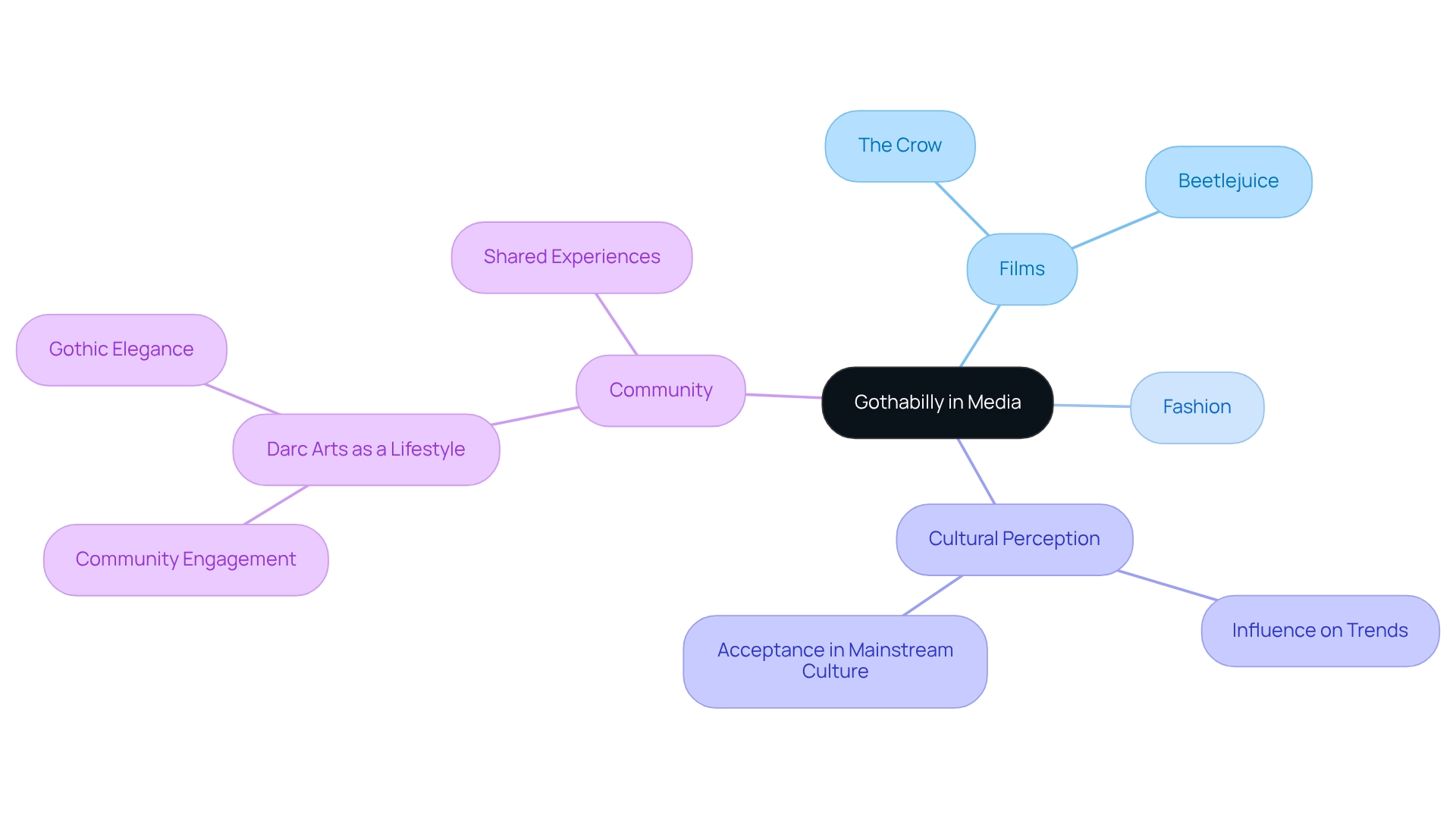
Exploring Gothabilly Brands and Vendors: Where to Find the Aesthetic
For those yearning to dive into a world of unique aesthetics, a plethora of brands and vendors beckon, each tailored to this distinctive style. Hell Bunny and Killstar emerge as front-runners, delivering an electrifying fusion of vintage rockabilly silhouettes and dark, gothic elements. These brands do more than just offer chic choices; they embody the very essence of the subculture, drawing in those who crave a heady mix of nostalgia and rebellion.
But it doesn't stop there. Online platforms like Etsy serve as treasure troves for independent designers crafting custom pieces that channel this aesthetic. Here, personalized expression reigns supreme, allowing enthusiasts to unearth one-of-a-kind items that resonate with their unique flair. And let’s not forget local boutiques and alternative clothing shops, which often showcase styles influenced by the Gothabilly aesthetic, making it a breeze for aficionados to discover attire that truly reflects their look.
Engaging with these brands and vendors does more than elevate personal style; it cultivates a sense of belonging within a vibrant community. As the market for alternative styles burgeons—predicted to be the fastest-growing segment in online sales by 2024—enthusiasts can look forward to an ever-expanding array of choices to flaunt their distinct identities.
Darc Arts perfectly encapsulates this lifestyle narrative, weaving a community around its brand where gothic elegance and wellness intertwine.
By exploring these avenues, individuals can connect with kindred spirits and celebrate the cultural roots of Dark Arts while embracing the unparalleled offerings of Gothabilly fashion.
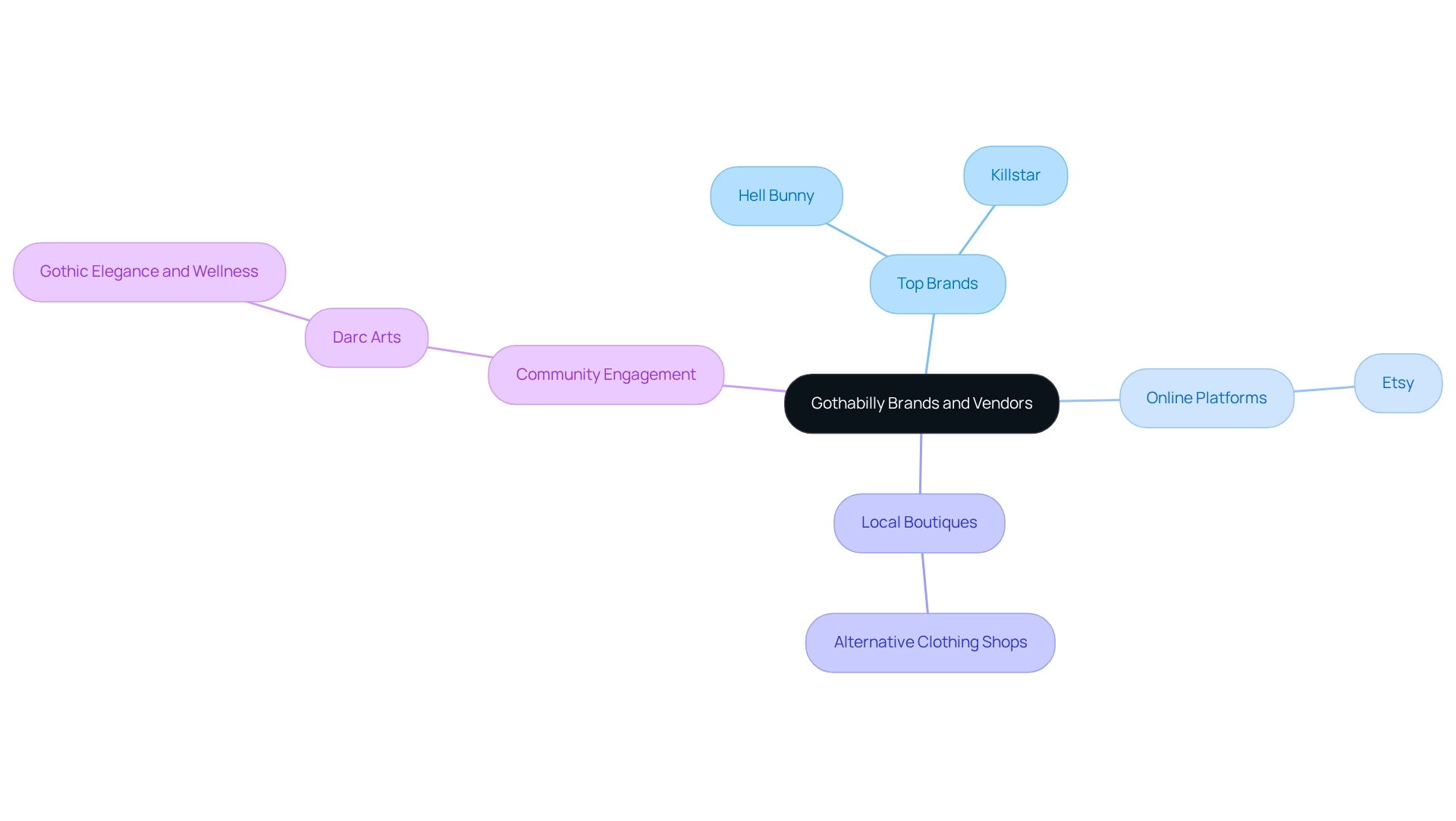
Conclusion
Gothabilly isn't just a genre; it's a vibrant cultural movement that fuses gothic elegance with rockabilly charm. Born in the late 1970s, it cultivates a unique aesthetic and fosters a community that revels in its darkly whimsical allure. With roots steeped in rockabilly, this subculture surges anew among younger generations, inviting enthusiasts to celebrate their individuality through fashion, music, and lifestyle choices.
Imagine skulls, bats, and retro patterns—these motifs embody the essence of Gothabilly. The musical landscape, rich with distinctive rhythms and haunting lyrics, resonates deeply with fans. Bands like The Cramps and The Coffinshakers have paved the way, blending humor with horror, igniting inspiration in new generations of artists. And let’s not forget the fashion: high-waisted skirts and dramatic accessories empower individuals to embrace their darker sides, making a bold statement.
As the Gothabilly community evolves, it mirrors broader cultural movements and societal changes, showcasing a dynamic interplay between tradition and modernity. Brands like Darc Arts exemplify this intersection, promoting a lifestyle that harmonizes gothic aesthetics with wellness. Gothabilly stands as a testament to the enduring allure of individuality and creativity, inviting all to delve into the rich tapestry of this captivating subculture. Embracing Gothabilly transcends mere style; it’s about celebrating a lifestyle that revels in the unconventional and the extraordinary. So, are you ready to explore this darkly enchanting world?
Frequently Asked Questions
What is gothabilly?
Gothabilly is a musical genre that combines the eerie allure of dark culture with the nostalgic vibe of rockabilly, emerging in the late 1970s through bands like The Cramps. It features dark visuals and upbeat, danceable rhythms, resonating with a diverse audience.
What themes are central to gothabilly?
At its core, gothabilly embodies themes of horror, nostalgia, and rebellion, celebrating individuality and creativity within a dark aesthetic framework.
How do enthusiasts express their gothabilly identity?
Enthusiasts often showcase their identity through a blend of vintage rockabilly attire, such as high-waisted skirts and leather jackets, infused with gothic elements like dark makeup, lace, and dramatic accessories.
What is the current trend regarding gothabilly culture?
There is a resurgence in the alternative culture scene, particularly among younger crowds, with increased participation in cultural events, music festivals, and social media sharing of the gothabilly aesthetic.
How does the Dark Arts movement relate to gothabilly?
The Dark Arts movement merges gothic elegance, cannabis wellness, and mystery, aligning with alternative culture and inviting individuals to explore their darker inclinations through quality THCA products.
What is the Darc Arts Promise?
The Darc Arts Promise ensures that THCA products are made from simple ingredients, comply with the 2018 Farm Bill (containing less than 0.3% Delta-9 THC), and provide a Certificate of Analysis for transparency and legal adherence.
How has rockabilly influenced gothabilly?
The vibrant rockabilly movement of the 1950s, characterized by a fusion of country music and rhythm and blues, laid the foundation for gothabilly. It evolved by intertwining with punk rock and dark subcultures, particularly in the late 1970s.
What visual elements are associated with the gothabilly aesthetic?
The gothabilly aesthetic features motifs like skulls, bats, and horror-themed imagery, often paired with dark colors such as black, red, and purple, alongside vintage silhouettes and accessories like fishnet stockings and chokers.
What impact does social media have on gothabilly fashion?
There has been a significant rise in social media interaction with fashion content, indicating a growing fascination with alternative subcultures, including gothabilly, and reflecting a broader cultural movement that blurs traditional style boundaries.
How does gothabilly serve as a lifestyle?
Gothabilly transcends mere style choice; it embodies a lifestyle that celebrates individuality and creativity, encouraging enthusiasts to explore their identities through both fashion and cultural participation.
